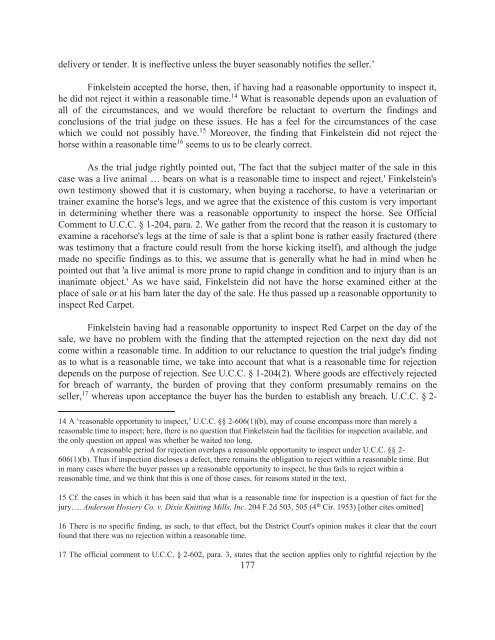Sales and Leases - A Problem-based Approach, 2016a
Sales and Leases - A Problem-based Approach, 2016a
Sales and Leases - A Problem-based Approach, 2016a
Create successful ePaper yourself
Turn your PDF publications into a flip-book with our unique Google optimized e-Paper software.
delivery or tender. It is ineffective unless the buyer seasonably notifies the seller.’<br />
Finkelstein accepted the horse, then, if having had a reasonable opportunity to inspect it,<br />
he did not reject it within a reasonable time. 14 What is reasonable depends upon an evaluation of<br />
all of the circumstances, <strong>and</strong> we would therefore be reluctant to overturn the findings <strong>and</strong><br />
conclusions of the trial judge on these issues. He has a feel for the circumstances of the case<br />
which we could not possibly have. 15 Moreover, the finding that Finkelstein did not reject the<br />
horse within a reasonable time 16 seems to us to be clearly correct.<br />
As the trial judge rightly pointed out, 'The fact that the subject matter of the sale in this<br />
case was a live animal … bears on what is a reasonable time to inspect <strong>and</strong> reject.' Finkelstein's<br />
own testimony showed that it is customary, when buying a racehorse, to have a veterinarian or<br />
trainer examine the horse's legs, <strong>and</strong> we agree that the existence of this custom is very important<br />
in determining whether there was a reasonable opportunity to inspect the horse. See Official<br />
Comment to U.C.C. § 1-204, para. 2. We gather from the record that the reason it is customary to<br />
examine a racehorse's legs at the time of sale is that a splint bone is rather easily fractured (there<br />
was testimony that a fracture could result from the horse kicking itself), <strong>and</strong> although the judge<br />
made no specific findings as to this, we assume that is generally what he had in mind when he<br />
pointed out that 'a live animal is more prone to rapid change in condition <strong>and</strong> to injury than is an<br />
inanimate object.' As we have said, Finkelstein did not have the horse examined either at the<br />
place of sale or at his barn later the day of the sale. He thus passed up a reasonable opportunity to<br />
inspect Red Carpet.<br />
Finkelstein having had a reasonable opportunity to inspect Red Carpet on the day of the<br />
sale, we have no problem with the finding that the attempted rejection on the next day did not<br />
come within a reasonable time. In addition to our reluctance to question the trial judge's finding<br />
as to what is a reasonable time, we take into account that what is a reasonable time for rejection<br />
depends on the purpose of rejection. See U.C.C. § 1-204(2). Where goods are effectively rejected<br />
for breach of warranty, the burden of proving that they conform presumably remains on the<br />
seller, 17 whereas upon acceptance the buyer has the burden to establish any breach. U.C.C. § 2-<br />
14 A ‘reasonable opportunity to inspect,’ U.C.C. §§ 2-606(1)(b), may of course encompass more than merely a<br />
reasonable time to inspect; here, there is no question that Finkelstein had the facilities for inspection available, <strong>and</strong><br />
the only question on appeal was whether he waited too long.<br />
A reasonable period for rejection overlaps a reasonable opportunity to inspect under U.C.C. §§ 2-<br />
606(1)(b). Thus if inspection discloses a defect, there remains the obligation to reject within a reasonable time. But<br />
in many cases where the buyer passes up a reasonable opportunity to inspect, he thus fails to reject within a<br />
reasonable time, <strong>and</strong> we think that this is one of those cases, for reasons stated in the text.<br />
15 Cf. the cases in which it has been said that what is a reasonable time for inspection is a question of fact for the<br />
jury…. Anderson Hosiery Co. v. Dixie Knitting Mills, Inc. 204 F.2d 503, 505 (4 th Cir. 1953) [other cites omitted]<br />
16 There is no specific finding, as such, to that effect, but the District Court's opinion makes it clear that the court<br />
found that there was no rejection within a reasonable time.<br />
17 The official comment to U.C.C. § 2-602, para. 3, states that the section applies only to rightful rejection by the<br />
177


















